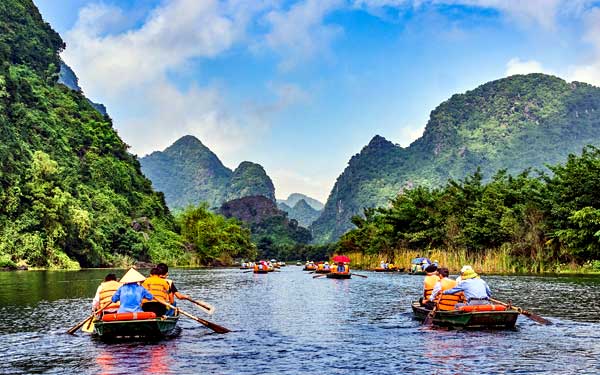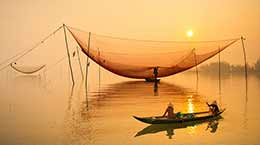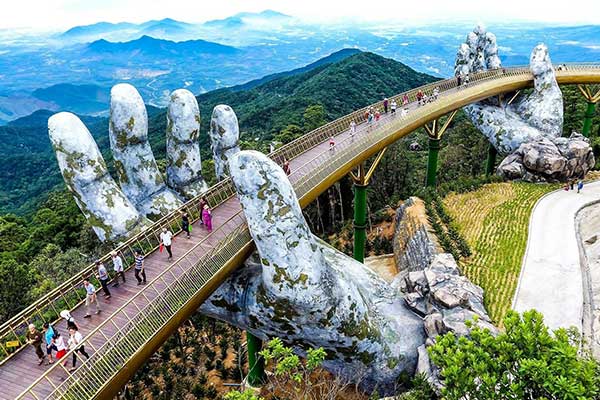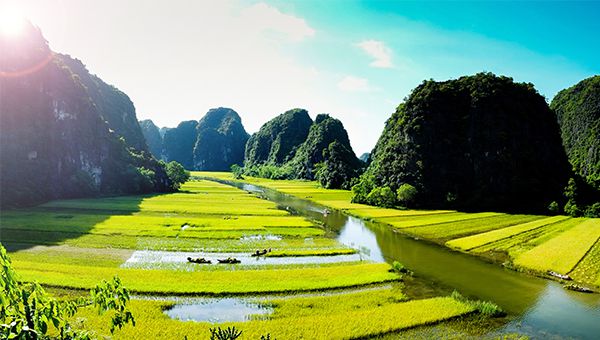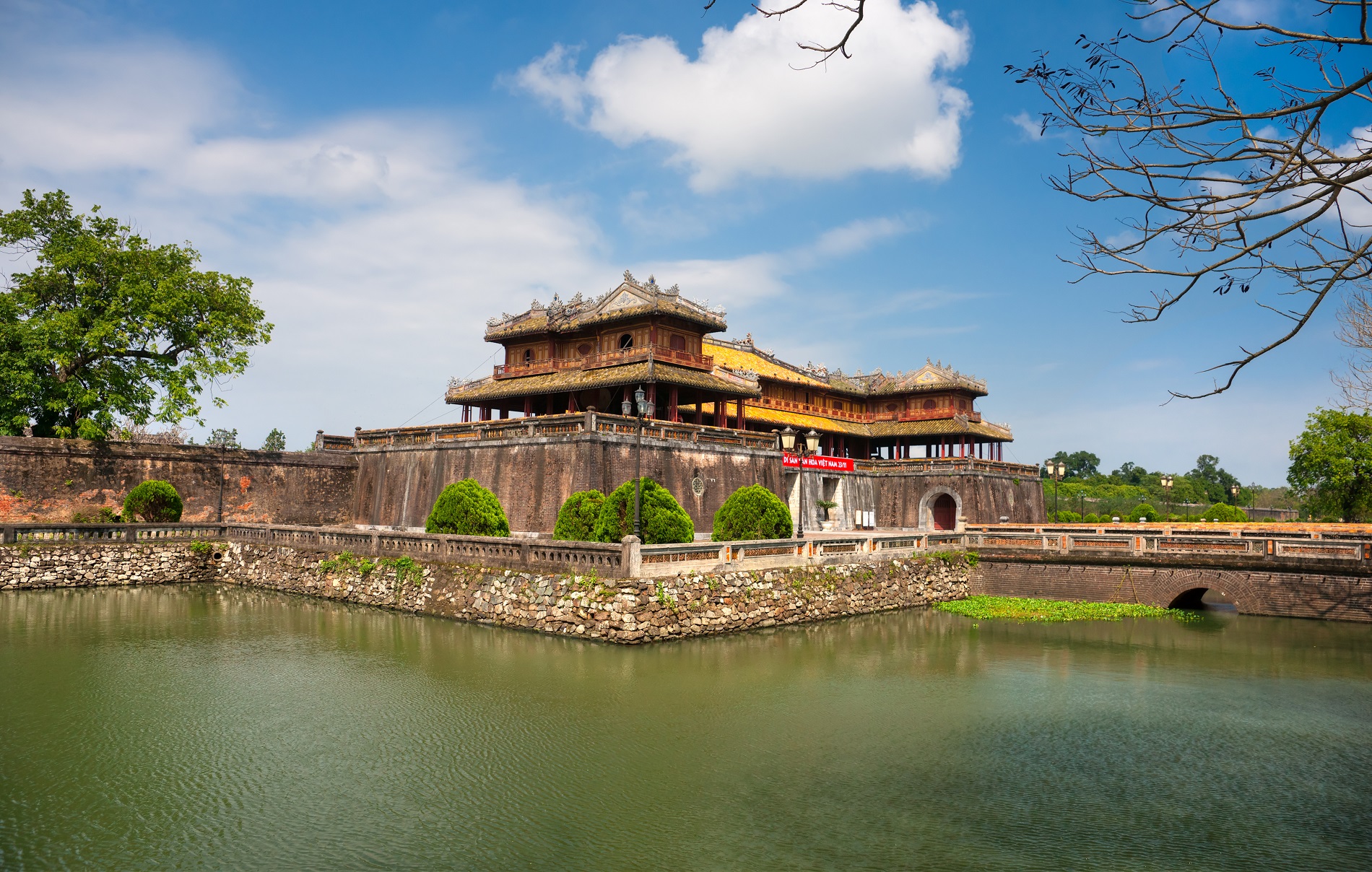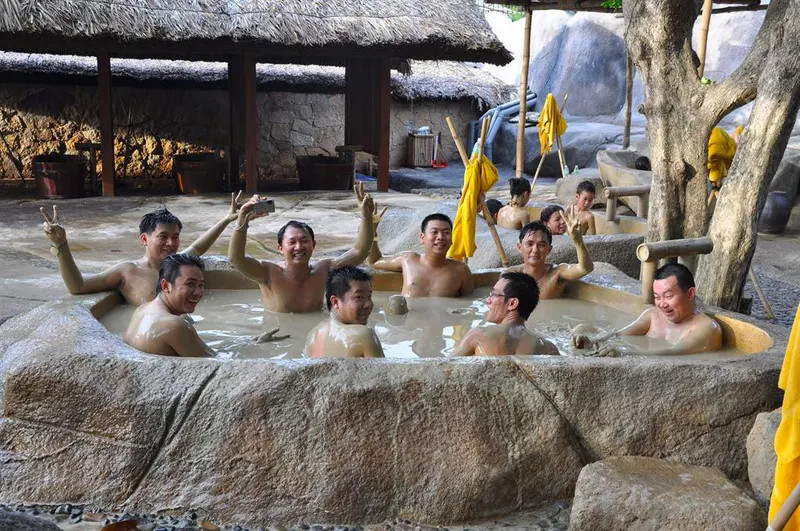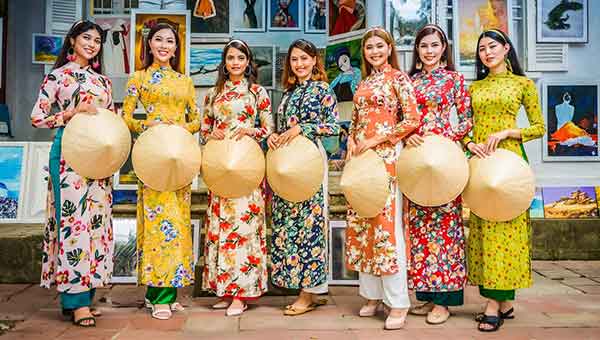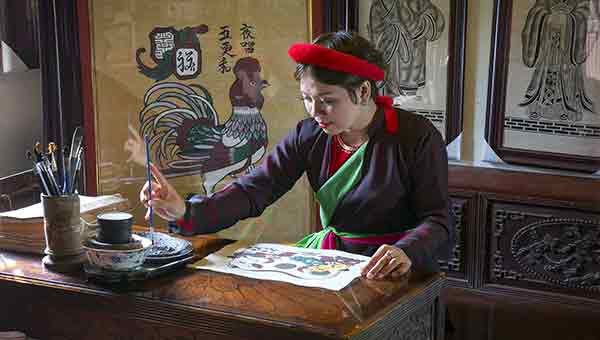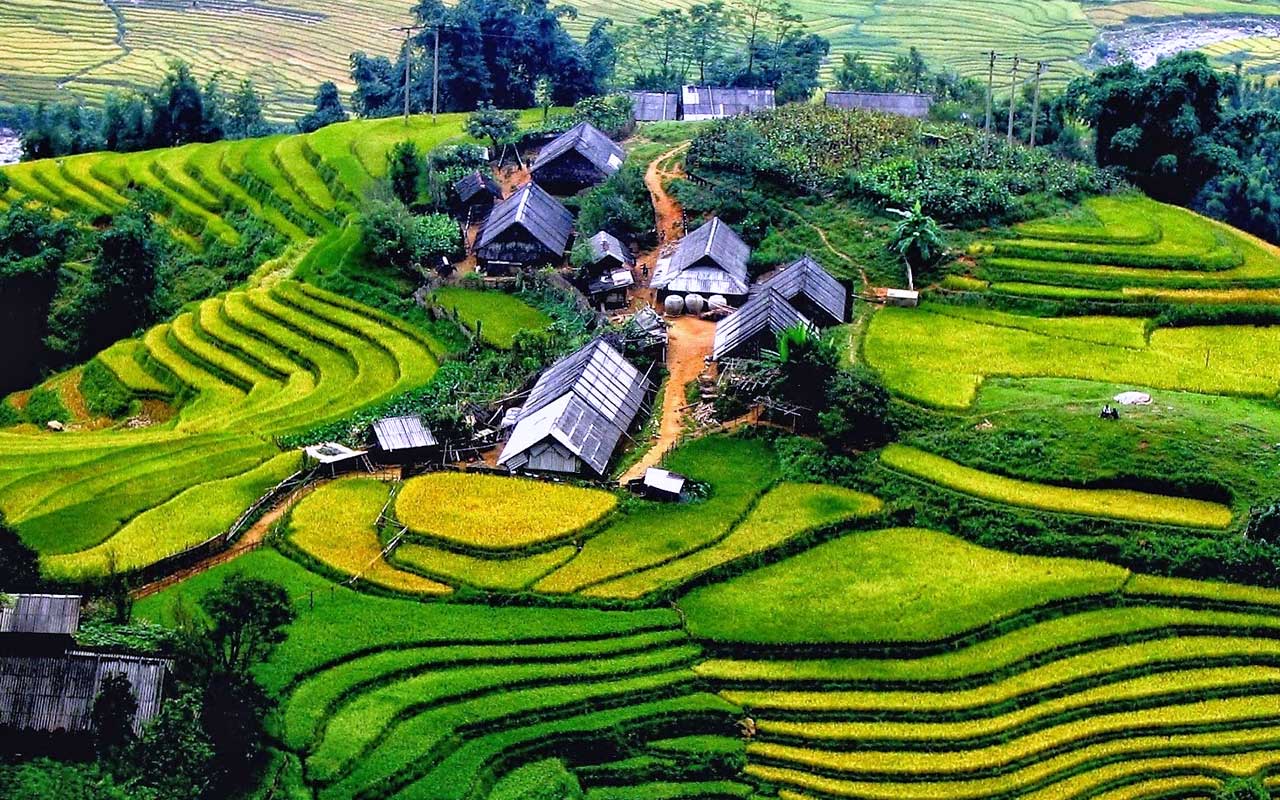
Vietnam is a Southeast Asian country that has a lot to offer for travelers who are interested in its culture, history, nature, and cuisine. Vietnam's tourism industry has been steadily growing in popularity, as more and more people discover its unique and diverse attractions. Whether you are looking for adventure, relaxation, or inspiration, you will find something that suits your taste and budget in Vietnam.
One of the reasons why Vietnam is a great destination is its rich and fascinating history, which spans from ancient times to modern days. You can visit some of the historical sites that showcase the country's heritage, such as the Imperial City of Hue, the ancient town of Hoi An, the Cu Chi tunnels, and the Ho Chi Minh Mausoleum. You can also learn more about the country's past and present by visiting some of the museums, monuments, and temples that reflect its culture and religion.
Another reason why Vietnam is a wonderful place to visit is its stunning and diverse landscapes, which range from mountains, forests, rivers, lakes, beaches, and islands. You can explore some of the natural wonders that Vietnam has to offer, such as the UNESCO World Heritage Site of Ha Long Bay, the majestic mountains of Sapa, the lush forests of Phong Nha-Ke Bang National Park, and the pristine beaches of Phu Quoc Island. You can also enjoy various activities, such as cruising, hiking, kayaking, and snorkeling, in these scenic locations.
A third reason why Vietnam is a must-see destination is its vibrant and delicious cuisine, which is famous for its freshness, variety, and flavor. You can taste some of the popular and regional dishes that Vietnam is known for, such as pho noodle soup, banh mi sandwiches, and fresh spring rolls, which can be found in street stalls, markets, and restaurants across the country. You can also join some of the colorful and lively festivals, such as Tet (Lunar New Year) and Mid-Autumn Festival, which celebrate the country's traditions and customs with food, music, and entertainment.
Vietnam is a country that will captivate you with its charm, beauty, and diversity. It is a place where you can experience the best of both worlds, from the ancient to the modern, from the rural to the urban, and from the simple to the sophisticated. Here are some of the most famous places that draw tourists from around the world to this beautiful country.
Halong Bay
Hạ Long Bay, or Halong Bay, is a UNESCO World Heritage Site and a popular travel destination located in Quảng Ninh province, Vietnam. The name Hạ Long means "descending dragon". The bay belongs to Hạ Long city, Cẩm Phả city, and is a part of Vân Đồn district.
The bay features thousands of limestone karsts and islets in various shapes and sizes. It is a center of a larger zone that includes Bai Tu Long Bay to the northeast, and Cát Bà Island to the southwest. These larger zones share similar geological, geographical, geomorphological, climate, and cultural characters.
Hạ Long Bay has an area of around 1,553 km², including 1,960–2,000 islets, most of which are limestone. The core of the bay has an area of 334 km² with a high density of 775 islets. The evolution of the karst in this bay has taken 20 million years under the impact of the tropical wet climate.
The bay is home to 14 endemic floral species and 60 endemic faunal species. Historical research surveys have shown the presence of prehistoric human beings in this area tens of thousands of years ago.
The bay is located in northeastern Vietnam, from E106°55’ to E107°37’ and from N20°43’ to N21°09’. The bay stretches from Quang Yen town, past Hạ Long city, Cẩm Phả city to Vân Đồn District, is bordered on the south and southeast by Lan Ha Bay, on the north by Hạ Long city, and on the west by Bai Tu Long Bay.
Most visitors take an overnight boat tour of Ha Long Bay to experience at least one sunset and one ethereal sunrise.
If you are planning to visit Ha Long Bay, here are some more useful and interesting information that might help you:
How to get from Hanoi to Halong
You can get to Ha Long Bay by bus, train, car, or plane. The most common way is to take a bus from Hanoi, which takes about 3-3.5 hours and costs around 15 USD. You can also take a train from Hanoi to Hai Phong, then a taxi to Cát Bà Island, then another ferry to Ha Long Bay, which takes about 6 hours and costs around $100 - $150 USD. Alternatively, you can book a private car in Hanoi or hire a driver from Hanoi, which takes about 3 hours and costs around 100 - $150 USD (include all fee like Toll,...).
When to go
The best time to visit Ha Long Bay is from October to April, when the weather is dry and cool, and the visibility is good. The peak season is from December to February, when the bay is crowded with tourists and prices are higher. The low season is from May to September, when the weather is hot and humid, and the bay is prone to storms and typhoons.
What to do
There are many activities and attractions to enjoy in Ha Long Bay, such as:
- Cruising: The most popular way to explore the bay is by taking a cruise, which can range from budget to luxury, and from day trips to overnight stays. You can choose from different types of boats, such as traditional wooden junks, modern steel vessels, or private yachts. A cruise will take you to the most scenic spots in the bay, such as Ti Top Island, Sung Sot Cave, Luon Cave, and Dau Go Cave. You can also enjoy onboard services and entertainment, such as meals, drinks, spa, karaoke, and cooking classes.
- Kayaking: Another way to experience the bay is by kayaking, which allows you to get closer to the water and the karsts. You can rent a kayak from your cruise or from a local operator, and paddle around the bay at your own pace. You can also join a guided kayaking tour, which will take you to some hidden lagoons, caves, and beaches. Kayaking is a fun and adventurous activity that lets you see the bay from a different perspective.
- Swimming and snorkeling: If you want to cool off and enjoy the marine life, you can go swimming and snorkeling in the bay. There are many spots where you can swim and snorkel, such as Bai Chay Beach, Ba Trai Dao Beach, and Lan Ha Bay. The water is clear and calm, and the coral reefs are colorful and diverse. You can see various fish, crabs, starfish, and sea urchins. Swimming and snorkeling are relaxing and refreshing activities that let you appreciate the beauty of the bay.
Hanoi
Hanoi is a city that offers a fascinating blend of old and new, where the past and the present coexist in a dynamic and diverse urban landscape. As the capital of Vietnam for over 1000 years, Hanoi has witnessed many historical events and cultural changes, which are reflected in its architecture, monuments, and people. Hanoi is also a city that embraces modernity and innovation, as it strives to become a leading center of economy, education, and culture in Southeast Asia. Whether you are interested in history, culture, or cuisine, Hanoi has something for everyone.
Here are some of the highlights of this amazing city:
- Hanoi's Old Quarter: This is the heart and soul of Hanoi, where you can experience the charm and vitality of the city's traditional life. The Old Quarter is a maze of narrow streets, each named after the craft or trade that was practiced there in the past, such as Hang Bac (silver), Hang Gai (silk), or Hang Ma (paper). You can find a variety of goods, from souvenirs and handicrafts to clothes and electronics, as well as street food stalls, cafes, and bars. The Old Quarter is also home to some of the oldest and most famous landmarks in Hanoi, such as the Bach Ma Temple, the Dong Xuan Market, and the Hoan Kiem Lake.
- Hanoi's French Quarter: This is the area where you can see the influence of the French colonial period, which lasted from the late 19th century to the mid-20th century. The French Quarter is characterized by elegant buildings, wide boulevards, and green parks, which contrast with the chaotic and crowded Old Quarter. Some of the most notable attractions in the French Quarter are the Opera House, the Sofitel Legend Metropole Hotel, the National Museum of Vietnamese History, and the St. Joseph's Cathedral.
- Hanoi's Ho Chi Minh Complex: This is the place where you can learn about the life and legacy of Ho Chi Minh, the revered leader of Vietnam's independence movement and the founder of the Democratic Republic of Vietnam. The complex consists of several sites, such as the Ho Chi Minh Mausoleum, where his embalmed body is displayed; the Ho Chi Minh Museum, where his personal belongings and memorabilia are exhibited; the Ho Chi Minh House, where he lived and worked from 1958 to 1969; and the One Pillar Pagoda, a symbol of his devotion to Buddhism.
- Hanoi's Temple of Literature: This is the oldest and most prestigious university in Vietnam, founded in 1070 by Emperor Ly Thanh Tong as a Confucian temple and a center of learning. The temple is dedicated to Confucius and his disciples, as well as to the scholars and sages of Vietnam. The temple consists of five courtyards, each with its own gate, pavilion, hall, and garden. The most impressive feature of the temple is the collection of 82 stone steles, which bear the names and achievements of the graduates of the royal examinations from the 15th to the 18th centuries.
- Hanoi's cuisine: Hanoi is a paradise for food lovers, as it offers a wide range of dishes that reflect the diversity and richness of its culture and history. Hanoi is famous for its street food, which can be found in every corner of the city, from the Old Quarter to the West Lake. Some of the most popular and delicious street food dishes in Hanoi are pho (noodle soup with beef or chicken), bun cha (grilled pork with rice noodles and herbs), banh mi (baguette sandwich with various fillings), cha ca (fried fish with turmeric and dill), and egg coffee (coffee with whipped egg yolk and condensed milk).
Hanoi is a city that never ceases to amaze and inspire its visitors, as it combines the ancient and the modern, the traditional and the contemporary, the east and the west, in a unique and harmonious way. Hanoi is a city that you will fall in love with, and a city that you will always remember.
Ho Chi Minh City (Saigon)
Ho Chi Minh City, also known as Saigon, is the largest and most dynamic city in Vietnam. It is a place where the past and the present collide, creating a fascinating blend of culture, history, and modernity. Whether you are looking for historical landmarks, cultural attractions, or vibrant nightlife, Ho Chi Minh City has something for everyone. Here are some of the highlights of this amazing city:
- War Remnants Museum: This museum displays the harsh realities of the Vietnam War and its impact on the Vietnamese people. You can see exhibits of weapons, vehicles, photographs, and artifacts that tell the stories of the victims and the survivors of the war. The museum also features a section dedicated to the anti-war movement around the world. The War Remnants Museum is a sobering and eye-opening experience that will make you appreciate the peace and freedom you enjoy today.
- Notre-Dame Cathedral Basilica of Saigon: This stunning cathedral is one of the most prominent examples of French colonial architecture in Ho Chi Minh City. It was built in the late 19th century with materials imported from France, such as the red bricks, the stained glass windows, and the iron spire. The cathedral is a symbol of Catholicism in Vietnam and a popular place for weddings and religious ceremonies. You can admire the exterior of the cathedral from the park in front of it, or visit the interior during the mass times.
- Ben Thanh Market: This is the most famous and busiest market in Ho Chi Minh City, where you can find everything from fresh fruits and vegetables, to clothes and souvenirs, to street food and coffee. The market is divided into four sections, each with its own entrance and color-coded sign. You can bargain with the vendors for the best prices, or just enjoy the lively atmosphere and the variety of goods. The market is open from 6 a.m. to 6 p.m., but you can also visit the night market outside the main building, which operates from 6 p.m. to 10 p.m.
- Bitexco Financial Tower: This is the tallest building in Ho Chi Minh City, standing at 262 meters high and 68 stories tall. It is a modern skyscraper that offers a panoramic view of the city skyline and the Saigon River. You can visit the observation deck on the 49th floor, or the helipad on the 52nd floor, which is the highest helipad in Vietnam. You can also enjoy a drink or a meal at the restaurants and bars on the upper floors, or shop at the mall on the lower floors.
- Bui Vien Street: This is the epicenter of Ho Chi Minh City's nightlife, where you can find a plethora of bars, clubs, pubs, and restaurants that cater to locals and foreigners alike. You can party all night long with live music, DJs, karaoke, and dancing, or just chill out with a beer and a snack. The street is also a hub for backpackers and budget travelers, as it offers many cheap hostels, hotels, and guesthouses. Bui Vien Street is a place where you can meet new people, have fun, and experience the energy of Ho Chi Minh City.
Ho Chi Minh City is a city that never sleeps, and never ceases to surprise and delight its visitors. It is a city that showcases the diversity and development of Vietnam, and a city that you will never forget.
Hue
Hue is a city that offers a fascinating glimpse into Vietnam’s imperial past, as it was the former capital under the Nguyen Dynasty from 1802 to 1945. If you are interested in history and culture, Hue is a destination that you should not miss.
Here are some of the reasons why Hue is worth visiting and what you can expect to see and do there.
- Hue Citadel: This is the most iconic attraction in Hue, as it was the seat of power and the residence of the Nguyen emperors for over a century. The citadel is a complex of palaces, temples, gates, walls, and moats, covering an area of 10 square kilometers. The citadel is divided into three sections: the Imperial City, the Forbidden Purple City, and the Inner City. You can explore the magnificent architecture and the rich history of the citadel, as well as admire the artifacts and relics displayed in the museums and galleries. The citadel is also a UNESCO World Heritage site, recognized for its cultural and historical value.
- Hue Royal Tombs: Another highlight of Hue is the royal tombs of the Nguyen emperors, which are scattered along the banks of the Perfume River. Each tomb reflects the personality and the reign of the emperor it belongs to, and showcases the art and the craftsmanship of the time. Some of the most famous and impressive tombs are the Tomb of Minh Mang, the Tomb of Tu Duc, the Tomb of Khai Dinh, and the Tomb of Gia Long. You can visit the tombs by boat, by bike, or by car, and enjoy the scenic views of the river and the countryside along the way.
- Perfume River: The Perfume River is the main river that flows through Hue, and it is named after the fragrant flowers that fall into the water in autumn. The river is not only a source of life and beauty for the city, but also a symbol of its history and culture. Along the river, you can see many historical and religious sites, such as the Thien Mu Pagoda, the Hon Chen Temple, the Bao Quoc Pagoda, and the Hue Citadel. You can also take a boat trip on the river, especially at night, and enjoy the romantic atmosphere and the cultural performances on board.
- Thien Mu Pagoda: This is the oldest and the most famous pagoda in Hue, dating back to the 17th century. It is located on a hill overlooking the Perfume River, and it is a prominent landmark of the city. The pagoda is known for its seven-story octagonal tower, which is the symbol of Hue. The pagoda also houses a large bell, a giant turtle, and a car that belonged to a monk who immolated himself in protest of the South Vietnamese regime in 1963. The pagoda is a place of worship and a place of history, and it offers a peaceful and serene atmosphere.
Hue is a city that has a lot to offer for history buffs, as it preserves the legacy and the heritage of the Nguyen Dynasty. Hue is also a city that has a unique charm and a distinctive culture, influenced by the Chinese, the French, and the Buddhist traditions. Hue is a city that you will enjoy exploring and discovering, and a city that you will learn a lot from.
Hoi An
Hoi An is a city that captivates visitors with its old-world charm and cultural diversity. As a former trading port from the 15th to the 19th centuries, Hoi An has preserved its historical and architectural heritage, as well as its rich and varied cuisine.
Here are some of the things you can do and see in Hoi An:
- Explore the Ancient Town: The Ancient Town of Hoi An is a UNESCO World Heritage Site that showcases the fusion of indigenous and foreign influences, such as Chinese, Japanese, and French. You can admire the colorful lanterns that light up the streets at night, visit the ancient houses and temples, shop for souvenirs and handicrafts, and enjoy the lively atmosphere. Some of the most notable attractions in the Ancient Town are the Japanese Covered Bridge, the Museum of Trade Ceramics, the Tan Ky House, and the Quan Cong Temple.
- Experience the Lantern Festival: The Lantern Festival is a monthly event that celebrates the full moon, which is considered a sacred time in the Buddhist calendar. On the 14th day of each lunar month, the Ancient Town turns off its electric lights and illuminates the streets with thousands of lanterns. You can join the locals and tourists in releasing paper lanterns into the river, making wishes and prayers, and watching cultural performances. The Lantern Festival is a magical and memorable experience that you should not miss.
- Taste the local cuisine: Hoi An is famous for its delicious and diverse cuisine, which reflects the city's history and culture. You can find a variety of dishes that are unique to Hoi An, such as Cao Lau, a noodle dish with pork and herbs; Banh Mi, a baguette sandwich with various fillings; Mi Quang, a noodle soup with meat and vegetables; and White Rose, a type of dumpling with shrimp or pork. You can also try other Vietnamese specialties, such as Pho, Banh Xeo, and Fried Wontons. You can taste the local cuisine at street stalls, markets, or restaurants, and even take a cooking class to learn how to make your own.
- Enjoy the beach and nature: Hoi An is not only a cultural and historical destination, but also a natural one. You can relax and have fun at the nearby beaches, such as An Bang, Cua Dai, and Ha My, where you can swim, sunbathe, surf, or kayak. You can also explore the countryside and the rural life of Hoi An, by taking a bike ride, a boat trip, or a walking tour. You can visit the rice fields, the coconut forests, the fishing villages, and the organic farms, and interact with the friendly locals.
Hoi An is a city that offers something for everyone, whether you are looking for history, culture, cuisine, or nature. Hoi An is a city that will enchant you with its beauty and diversity, and make you want to come back again and again.
Phong Nha-Ke Bang National Park
Phong Nha-Ke Bang National Park is a UNESCO World Heritage Site located in Quang Binh province, Vietnam. It is one of the most spectacular natural wonders in Southeast Asia, boasting a rich biodiversity, a complex geological history, and a stunning landscape of karst mountains, tropical forests, and underground rivers. For adventurous travelers, Phong Nha-Ke Bang offers a variety of activities and attractions to explore and enjoy.
One of the main attractions of the park is the Son Doong Cave, which is the world's largest cave passage in terms of diameter and continuity. Discovered in 1990 by a local man named Ho Khanh, and explored by a British-Vietnamese team in 2009, Son Doong Cave is a marvel of nature that spans nearly 9 km in length, 200 m in height, and 150 m in width. The cave contains its own ecosystem, with primaeval rainforests, diverse wildlife, and spectacular formations of stalactites and stalagmites. The cave also features a 70 m high calcite wall called the Great Wall of Vietnam, and a doline (collapsed ceiling) that allows sunlight to enter and create a magical scene of mist and vegetation. Son Doong Cave is only accessible by a four-day expedition organized by Oxalis Adventure, the sole operator licensed to run tours to the cave.
Another highlight of the park is the Phong Nha Cave, which is the most famous and visited cave in the area. The cave is accessible by boat from the Son River, and visitors can admire the impressive entrance, which is 20 m high and 10 m wide. The cave extends for over 44 km, but only the first 1.5 km is open to tourists. The cave features a series of chambers with different names, such as the Bi Ky Chamber, the Co Tien Chamber, and the Cung Dinh Chamber, each with its own unique beauty and characteristics. The cave also contains a subterranean river that flows for 13.969 km, making it the longest underground river in the world.
For those who love hiking and nature, the park offers several trails that lead to scenic spots and natural attractions. One of the most popular trails is the Paradise Cave Trail, which takes about two hours to complete and passes through dense forest, limestone hills, and streams. The trail ends at the Paradise Cave, which is considered to be the most beautiful cave in the park. The cave is 31 km long and has a width of up to 150 m and a height of up to 100 m. The cave is well-lit and has a wooden walkway that allows visitors to explore the first kilometer of the cave. The cave is famous for its spectacular formations of stalactites, stalagmites, columns, and flowstones, which create a fairy-tale-like atmosphere.
Another trail that is worth trying is the Nuoc Mooc Spring Trail, which is a 3 km loop that follows a crystal-clear stream that originates from the Phong Nha Cave. The trail is easy and suitable for all ages, and offers a refreshing and relaxing experience in nature. Along the way, visitors can see various plants and animals, such as orchids, ferns, butterflies, and birds. The trail also passes by several pools and waterfalls, where visitors can swim and cool off. The trail ends at the So Ot Spring, which is a turquoise pool surrounded by greenery and rocks. The spring is a popular spot for picnics and relaxation.
Phong Nha-Ke Bang National Park is a must-see destination for anyone who loves adventure, nature, and culture. The park has something for everyone, whether it is exploring the world's largest cave, admiring the beauty of the underground river, hiking through the jungle, or swimming in the spring. The park is also home to several ethnic minority groups, such as the Bru-Van Kieu and the Chut, who have their own traditions and customs. Visitors can learn more about their culture and history at the Phong Nha-Ke Bang Visitor Center, which has exhibits, displays, and information about the park and its people. Phong Nha-Ke Bang National Park is a place where nature and culture meet, and where visitors can discover the wonders and secrets of Vietnam.
Cu Chi Tunnels
If you are interested in learning more about Vietnam's wartime history, you might want to visit the Cu Chi tunnels and the Mekong Delta, two of the most popular and significant attractions in the southern region of the country. These two destinations offer a contrast between the dark and tragic past of the war and the vibrant and colorful present of the rural life.
The Cu Chi tunnels are located about 70 km northwest of Ho Chi Minh City, the largest and most modern city in Vietnam. They are a complex network of underground tunnels that stretch for more than 250 km, connecting different villages and hiding places of the Viet Cong, the communist guerrillas who fought against the American forces during the Vietnam War. The tunnels were dug by hand using simple tools and were used for various purposes, such as living quarters, command centers, hospitals, kitchens, weapon factories, and trap doors. The tunnels were also equipped with ventilation systems, booby traps, and secret entrances to avoid detection and infiltration by the enemy.
Visiting the Cu Chi tunnels, you will have a chance to see how the Viet Cong soldiers lived and fought in the harsh conditions of the war. You can watch a documentary film that shows the history and construction of the tunnels, as well as the daily life and activities of the people inside. You can also explore some of the tunnels that have been widened and reinforced for tourists, and experience the claustrophobic feeling of crawling through the narrow and dark passages. You can also see some of the weapons and traps that were used by the Viet Cong, such as bamboo spikes, grenades, mines, and rifles. If you are feeling adventurous, you can even try shooting a real gun at the shooting range, for an extra fee. You can also taste the simple food that the soldiers ate, such as boiled cassava with salt and peanut sauce.
After visiting the Cu Chi tunnels, you can continue your journey to the Mekong Delta, a vast and fertile region that covers about 40,000 square km in the southwest of Vietnam. The Mekong Delta is where the Mekong River, the longest and most important river in Southeast Asia, splits into nine branches and flows into the East Vietnam Sea. The delta is home to millions of people who live on the water and cultivate various crops, especially rice, fruits, and vegetables. The delta is also known for its rich and diverse culture, with influences from different ethnic groups, religions, and traditions.
One of the best ways to explore the Mekong Delta is to take a boat tour along the river and its canals, where you can admire the scenic views of the green fields, coconut palms, floating markets, and stilt houses. You can also visit some of the islands and villages that dot the delta, such as My Tho, Ben Tre, Vinh Long, and Can Tho. There, you can learn more about the local customs and crafts, such as coconut candy making, honey bee farming, and mat weaving.
You can also sample some of the delicious and exotic fruits and dishes that the delta is famous for, such as dragon fruit, jackfruit, durian, banh xeo (crispy pancake), and hu tieu (rice noodle soup). You can also enjoy some of the traditional music and art forms of the region, such as don ca tai tu (southern folk music) and cai luong (southern opera).
The Cu Chi tunnels and the Mekong Delta are two destinations that will give you a deeper and more authentic understanding of Vietnam's history and culture. They are both worth visiting and experiencing, as they will show you the resilience and diversity of the Vietnamese people.
Mekong Delta
The Mekong Delta is a region of southern Vietnam that covers an area of about 40,000 square kilometers, where the Mekong River splits into nine branches before flowing into the South China Sea. The delta is also known as the "rice bowl" of Vietnam, as it produces more than half of the country's rice, as well as other crops such as fruits, vegetables, and fish.
The delta is a fascinating destination for travelers who want to experience the traditional and rural aspects of Vietnamese culture, as well as enjoy the natural beauty and diversity of the landscape.
One of the best ways to explore the Mekong Delta is by taking a cruise along the river and its canals, which are the lifelines of the local people. There are many options for cruising the Mekong Delta, ranging from luxury boats to simple sampans, and from day trips to overnight stays.
A cruise will allow you to see the daily activities and interactions of the people who live on and by the water, such as fishing, farming, trading, and worshipping. You will also have the opportunity to visit various attractions and landmarks along the way, such as floating markets, temples, pagodas, villages, and islands.
Some of the highlights of a Mekong Delta cruise are:
- Floating markets: These are the most famous and colorful features of the delta, where hundreds of boats gather to sell and buy goods, especially fruits and vegetables. The largest and most popular floating market is the Cai Rang market near Can Tho, which operates from early morning until noon. You can see the boats displaying their products on long poles, and hear the vendors shouting and bargaining. You can also buy some snacks and drinks from the smaller boats that serve as mobile cafes. Other floating markets that you can visit are the Cai Be market near Vinh Long, the Phung Hiep market near Hau Giang, and the Nga Bay market near Soc Trang.
- Temples and pagodas: The Mekong Delta is home to many religious sites that reflect the diversity and harmony of the region's beliefs and cultures. You can visit the Cao Dai Temple in Tay Ninh, which is the headquarters of the Cao Dai religion, a syncretic faith that combines elements of Buddhism, Taoism, Confucianism, Christianity, and Islam. The temple is a striking example of Cao Dai architecture, with a colorful facade, a nine-story tower, and a huge eye symbol. You can also visit the Vinh Trang Pagoda in My Tho, which is one of the largest and oldest Buddhist temples in the delta. The pagoda is a blend of Vietnamese, Chinese, and European styles, and features three giant Buddha statues, a lotus pond, and a bonsai garden.
- Villages and islands: The Mekong Delta is dotted with many charming and authentic villages and islands that offer a glimpse into the rural and traditional lifestyles of the locals. You can visit the Ben Tre province, which is known as the "coconut kingdom" of Vietnam, and see how the locals make various products from coconut, such as candy, oil, and handicrafts. You can also visit the Tra Su Cajuput Forest in An Giang, which is a 850-hectare wetland that hosts a rich biodiversity of flora and fauna. You can take a sampan ride through the forest and see the cajuput trees, water lilies, lotuses, birds, and fish. Another option is to visit the Phu Quoc Island, which is the largest and most beautiful island in the delta. The island is famous for its pristine beaches, crystal-clear water, coral reefs, and seafood.
A Mekong Delta cruise is a wonderful way to discover the hidden gems and secrets of Vietnam's southern region. You will be amazed by the scenery, the culture, and the people that you will encounter along the way. You will also learn more about the history, the challenges, and the opportunities that the delta faces in the present and the future. A Mekong Delta cruise is an unforgettable experience that you will cherish for a lifetime.
Cuisine and Festivals
Vietnam is a country that offers a rich and diverse range of experiences for travelers who want to explore its culture, history, nature, and cuisine. Whether you are looking for adventure, relaxation, or inspiration, you will find something that suits your taste and budget in Vietnam.
One of the main attractions of Vietnam is its food, which is famous for its freshness, variety, and flavor. Vietnamese cuisine reflects the country's geography, climate, and history. Some of the most popular dishes include pho noodle soup, Banh mi sandwiches, and fresh spring rolls, which can be found in street stalls, markets, and restaurants across the country.
You can also try some of the regional specialties, such as Bun Cha (grilled pork and noodles) in Hanoi, Cao Lau (noodles with pork and herbs) in Hoi An, and Banh Xeo (crispy pancakes with shrimp and bean sprouts) in Ho Chi Minh City. If you want to learn more about the secrets and stories behind Vietnamese food, you can join a Vietnamese food tour, which will take you to the best places to eat and drink, and introduce you to the local ingredients, cooking techniques, and etiquette.
Another way to experience Vietnam is to join its colorful and lively festivals, which celebrate its cultural and religious traditions. The most important festival is Tet, or the Lunar New Year, which usually falls in late January or early February. Tet is a time for family reunions, ancestral worship, house cleaning, and gift giving. It is also a time for fun and entertainment, with fireworks, dragon dances, flower markets, and games.
You can join the festive atmosphere by visiting temples, pagodas, and public places, where you can see the decorations, performances, and rituals. You can also taste some of the special foods that are prepared for Tet, such as Banh Chung (sticky rice cake with pork and beans), Mut (candied fruits and nuts), and Thit Kho (braised pork with eggs).
Another festival that you can enjoy in Vietnam is the Mid-Autumn Festival, which is held on the 15th day of the eighth lunar month, usually in September or October. The Mid-Autumn Festival is a celebration of the harvest, the moon, and the children. It is also known as the Moon Festival, because people admire the full moon and eat mooncakes, which are pastries filled with lotus seeds, nuts, or egg yolks. The festival is also a time for children to have fun, as they play with lanterns, masks, and toys, and participate in lion dances, parades, and contests. You can join the festivities by visiting the Old Quarter in Hanoi, where you can see the lanterns, mooncakes, and performances, or by going to a rural village, where you can see the traditional customs and games.
Vietnam is not only a place for food and festivals, but also for nature and adventure. The country has a diverse and stunning landscape, with mountains, forests, rivers, lakes, beaches, and islands. You can explore the natural wonders of Vietnam by hiking, biking, kayaking, or cruising, depending on your preference and skill level.
Some of the most amazing places to visit in Vietnam are Ha Long Bay, a UNESCO World Heritage Site that features thousands of limestone karsts and islets; Phong Nha-Ke Bang National Park, another UNESCO World Heritage Site that contains the world's largest cave, Hang Son Doong; and Sapa, a mountainous town that offers breathtaking views of rice terraces, waterfalls, and ethnic minority villages.
With its storied past, striking scenery, delectable food, and cultural treasures - plus warm hospitality - Vietnam offers epic and engaging experiences for all types of travelers. As infrastructure improves and word spreads about its allure, Vietnam's tourism continues flourishing. If you want to plan your trip to Vietnam, please using our custom Vietnam Tour tool online or contact us.
